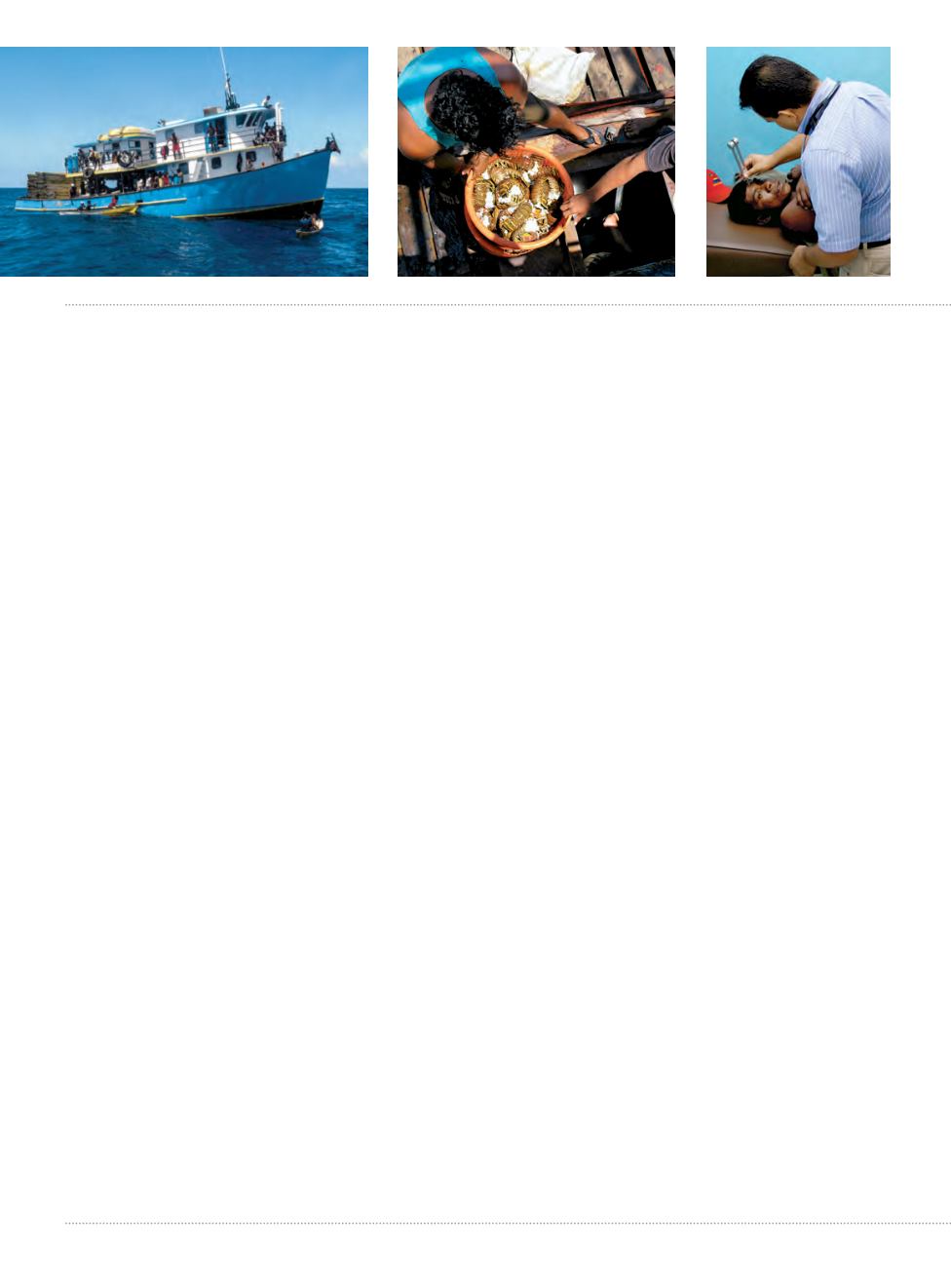
two weeks can mean up to $200, a windfall in an area
where per-capita annual income is US $1,600.
Oscar was on his sixth tank of the day when
the mermaid struck. Dreaming of the mermaid is
dangerous in local lore — the siren catches the diver
and keeps him in the deep. The DCS manifested
as searing pain down his left leg, then complete
paralysis. The other divers tried to relieve his pain,
taking him back underwater with two tanks of air to
try to recompress him, but he still couldn’t move his
legs. Oxygen, the mainstay of treating DCS, is never
available on the boats. We gently cradled Oscar into
the chamber and began the treatment.
I joined Oscar in the hyperbaric chamber. Equalizing
my ears as the chamber pressurized, the temperature
gradually rose to sauna levels. Because of the fire risk,
no electronics are allowed in the claustrophobia-
inducing chamber, and permission to read books
means little to the illiterate divers. Although up to five
people can fit in the main chamber, the sucking masks
of hyperbaric oxygen tightly affixed to the patients’
faces stymied my attempts at conversation. The
treatment, a U.S. Navy Treatment Table 6, lasts nearly
five hours. But Oscar is used to waiting — he arrived
five days after his injury because the lobster boat
needed to complete its fishing trip; medical care for an
injured diver was not the priority.
The next divers I met, three men in their 30s to
early 50s, were lucky to arrive within two days of their
injuries. A fourth diver was pulled convulsing from
the water, paralyzed and soon comatose; he died a day
later. The fishing expedition was terminated early so
he could be buried. Thus far, there had been 15 deaths
this season. This was the fourth death for the same
boat owner in the four months of the season so far, and
the worst months, November and December, still had
not started. Mejía commented that divers are injured
on some captains’ boats regularly, “[they have] little
graveyards to their names,” while other captains rarely
have injured divers.
Being wheelchair-dependent is a death sentence
for the divers. After they become dependent on a
foley catheter to urinate, divers will live an average
of two years, generally succumbing to pressure sores
and urinary tract infections. They also present an
economic burden on their families and communities,
depending on others to provide for their basic needs.
The dive-boat owners are supposed to be
responsible for the divers’ illnesses. For each U.S. Navy
Treatment Table 5 (a shorter chamber visit commonly
used for follow-up treatment), the patient needs one
or two tanks of oxygen. Each oxygen tank refill costs
$28, roughly a week’s wage for an average worker.
This represents the cost of the oxygen only, and the
expenses quickly escalate depending on the length of
the treatment. For every 10 divers the clinic treats, it
gets paid for only three. Boat owners commonly drop
off the patient and then refuse to answer their phone.
The clinic is stuck with the cost of medical care and
oxygen and sometimes pays for the patient’s food and
transportation back to La Moskitia.
The three divers recovered quickly, leaving after two
treatments, but Oscar’s recovery is more measured.
Every day after his hyperbaric treatment he’s on
the stationary bicycle; he frequently paces the clinic
grounds, willing his leg to get better. He talks about
the dangers the divers face underwater such as
barracudas, sharks and other more mythical creatures.
The fish that captures my imagination is known
locally as the pega pega. This fish is territorial and has
the strange tendency to strategically strike at men’s
nipples. According to local lore, if a diver encounters
this fish, his wife is unfaithful. Furthermore, the meat
of the fish can be a powerful aphrodisiac. Adamantly
denying using the fish for romantic prowess, he teases,
“I’d have more children if I used it.”
Mejía has been pushing the limits and knowledge of
hyperbaric medicine. Conventional wisdom holds that
hyperbaric treatment is no longer useful more than
two weeks after an injury. Even if a patient has been
afflicted by his injuries for a prolonged period, Mejía
tries hyperbaric treatment; the longest delay after which
88
|
WINTER 2014
ERIC DOUGLAS
JOSHUA WOLFF
ERIC DOUGLAS


